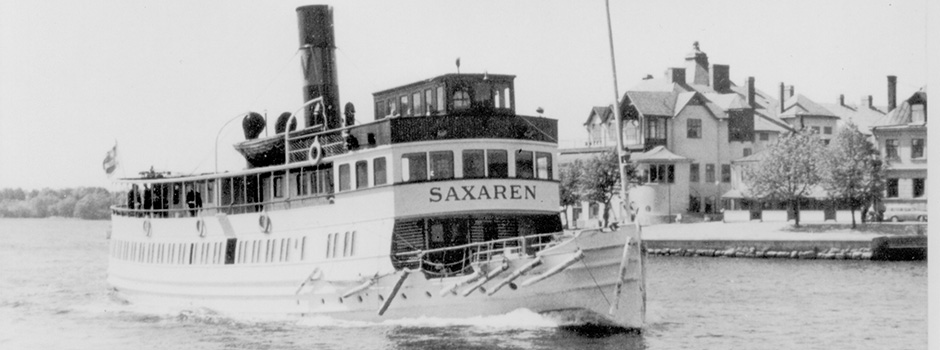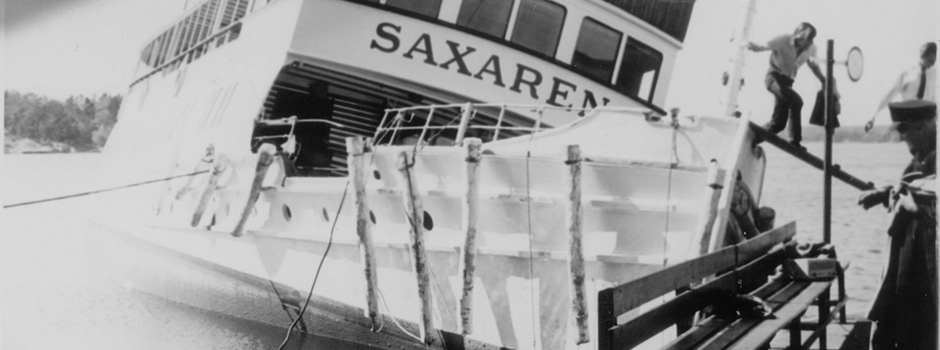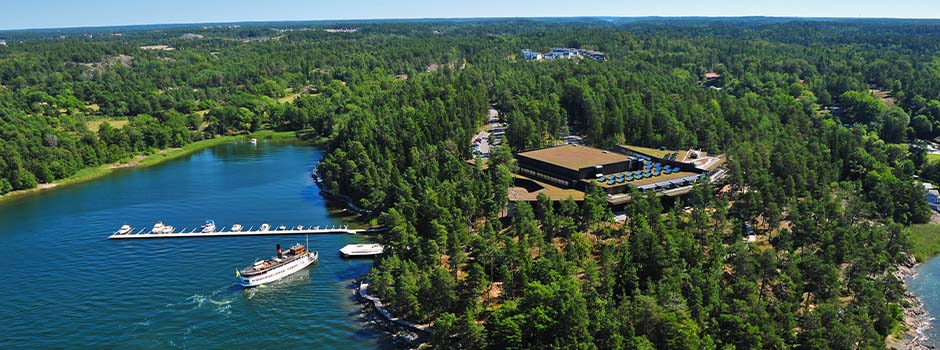The ship’s history, and current food cruises and excursions
Time for next part of our blog series about Stromma’s vintage boats. If you’re fascinated by vintage boats and history, don't miss out on reading all our previously published posts, you’ll find a list of links at the end of this post. However, this time we’re sharing the story of the “porcelain boat” the M/S Gustafsberg VII. It’s a dramatic story that might easily have had a tragic ending, with just another rotting shipwreck in the archipelago. At the bottom of the post, there is a map with the departure point for M/S Gustavsberg VII marked.
The Gustavsberg porcelain factory
The Gustavsberg porcelain factory was founded in the mid-1820s. Over the years, the factory changed hands several times, at the same time as it grew larger. The owners had clear visions for developing the entire company and the surrounding community. The goal was a self-sufficient community that also included farms. In order to transport the factory’s products to Stockholm and the intended customers, a functioning communication system was also needed all year round via the waterways to the capital city. This is how steamships also came to play a role in the factory and community system; the boats were designed to navigate the very shallow straits at Baggenstäket and to push through sea ice.

About the history of M/S Gustavsberg VII
Before the 1912 Olympic Games in Stockholm, the porcelain factory was anticipating a huge increase in demand and therefore needed another boat. Oskarshamns Mekaniska Verkstad won the contract to build the new steamer for the agreed price of SEK 155,000. The new steamer was named the Gustafsberg VII and was put into regular service on 19 May 1912.
Many new modernities on board
The new steamer showcased a number of modernities, such as machine telegraph and voice tubes – a short distance voice transmission device, e.g. between two rooms – central heating and an electric bell from the aft lounge, captain’s cabin, ladies’ cabins, conversation cabin both fore and aft, from the wheelhouse to the pantry. The steamer also boasted electric lighting and bathrooms with – prepare to be amazed – a shower! The dining room, which was classified as First Class, was located on the upper deck, thus giving the guests a magnificent view. On the tween deck, there was a ladies’ lounge officers’ cabins, as well as a lavish aft lounge and a fore lounge that was classified as Second Class.
Waitress Brita Borgstedt remembers
Brita Borgstedt, a waitress who worked on board the M/S Gustafsberg VII in her early days afloat, recalls:
“In the dining room, there were four large tables and a few smaller tables to keep track of. We served an à la carte menu on the 11 o’ clock service. Dishes such as steak with onions, chops and ham with eggs. On the 5:15 service, we served dinner with a choice of at least three main courses on the menu, such as poached whitefish, veal fricassee and Swedish beef stew. For desserts, there was often some fruit or mousse. And you had to order a sandwich to be allowed to order a Pilsner. These were government regulations, so sometimes the same sandwich went back and forth between guests who were just thirsty.”
A new era for steamboat services
By the mid-1920s, the modern era had caught up with the steamboat service on the Gustavsberg-Stockholm route. They built a bridge over Skurusundet and started a new bus service to Gustavsberg in 1929. The year before, Gustavsberg has also reached the conclusion that the steamboat service was far too expensive to operate as before. So in December 1929, the M/S Gustafsberg VII was sold to Waxholms Nya Ångfartygs AB and she was renamed “Saxaren” after Saxarfjärden, which was located in the area that she was going to operate. At the beginning of the 1930s, large parts of the Saxar Islands (the area south-west of Ljusterö) were developed, and a number of “sport cabins” were built and they attracted a new type of passenger. The “sporty outdoor life” made its debut in the archipelago.

From the seabed to gem of a ship
The Saxaren served as an icebreaker, passenger boat and cargo boat for agricultural products in the archipelago for many years, but on 21 May 1964 this all came to an abrupt end. The Saxaren ran aground. They managed to move her to a floating jetty, only for her crew to watch helplessly as she slowly capsized and sank to the bottom. During the summer, her fate hung in the balance, but eventually she was salvaged and towed into Stockholm.
Acquired by Stromma
After some best-forgotten tours as a party boat, when sadly some of her remaining original furnishings disappeared, she was acquired by Stromma in the autumn of 1973 with financial assistance from the Archipelago Boat Foundation. A major restoration and refurbishment was carried out to bring the ship back to her former glory. In recent years, she has undergone further restorations, all done with a sympathetic touch and feel, so that her furnishings and interior design once again reflect the prevailing style and design of the 1910s.

M/S Gustafsberg VII today – excursions, food cruises & Christmas buffets
In the summer, you can join us on our guided excursions Grand Canal Tour to Artipelag or Gustavsberg. You choose at which of these destinations you want to stop for a visit. There is on-board commentary provided by a live guide on both the outward and homeward journey. The route passes Baggenstäket and Skurusundet – two of Stockholm’s most beautiful waterways. On this tour, the journey is as much a part of the overall experience as the destination itself. The fact that the boat is also very beautiful, with its spacious dining room, cosy aft lounge and generous outdoor decking, explains why guests give the boat and her tours rave reviews.
Charter the M/S Gustafsberg VII for parties and weddings
The M/S Gustafsberg is one of Stromma’s most popular boats to charter for birthday parties, weddings and corporate events – largely because of the large, beautiful dining room with space for around 125 guests on the upper deck with direct access to an outdoor deck. The outdoor deck is the perfect place to serve welcome drinks, and it is also ideal for buffets, entertainment and dancing.
Blog series about the Strömma Kanalbolaget boats
This is post number five in our blog series where we highlight and tell you more about selected vessels from our fleet. In our previously published posts, we have written about the vessels S/S Stockholm, M/S Waxholm III, M/S Östanå I and M/S Prins Carl Philip.
Here you can read about the S/S Stockholm
Here you can read about the M/S Waxholm III
Here you can read about the M/S Östanå
Here you can read about the M/S Prins Carl Philip
Map - Departure Point for M/S Gustafsberg VII




